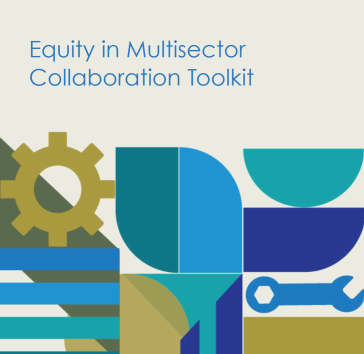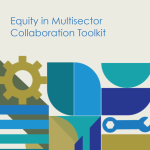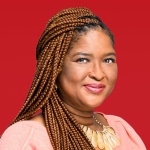Lessons from an equity toolkit workshop: facilitator perspective on participatory engagement

Originally posted in the GIH Bulletin on Oct. 20, 2023
Views from the field
Blue Shield of California Foundation is a long-time multisector collaborative funder with a health equity focus. Increasingly, we find that multisector collaboratives are a powerful vehicle to change systems toward racial equity. We heard from our partners and grantees a strong need for tools and resources that provide several outcomes: to establish equity at the collaborative level, to outline an arc of learning to help place a collaborative on an equity spectrum, and to provide tools to help collaboratives move deeper into equity. To support this work, the Equity in Multisector Collaboration Toolkit was developed in partnership with Cristobal Consulting. Its goal is to help multisector collaboratives see where they are taking concrete actions to center equity—and where they are not—through an embedded equity assessment.
In service of sharing the toolkit, the team at Blue Shield of California Foundation led a participatory workshop for health funders at the 2023 Grantmakers In Health (GIH) annual conference held in Minneapolis. We went beyond a typical presentation to participatory learning, reflecting the values of collaboration and cooperation between facilitators and session participants. We designed our workshop to include many visual, auditory, and tactile learning styles while including the following modules:
- Explaining the rationale behind the equity toolkit and our methodology.
- Grounding session participants in the critical equity values and capabilities that are the foundation for the equity assessment.
- Allowing participants to rate themselves on the forming, learning, and thriving indicator scales.
- Having participants reflect on why they scored themselves the way they did and determine the next steps to moving along the equity journey.
Entering the session space and starting the conversation
During the GIH conference, participants experienced many sessions, conversations, and plenaries about equity. As part of our workshop, we asked participants to pair up to discuss their reflections and learnings from the GIH conference. We then moved to a deeper discussion on the identity participants brought into their equity work. They acknowledged they were not just funders but also community members, parents, and BIPOC people in predominantly white spaces. Observing the groups, we saw people begin to relax and listen to their partners. We heard laughter, hugs, and some tears as everyone had a chance to share their GIH conference experience and their personal experiences within their communities and work lives.
Learning in space and place
With an understanding of the toolkit’s purpose and content, we provided an assessment experience by having participants place themselves in different parts of the room that held corresponding equity core indicator signs of forming, learning, and thriving. This was meant to acknowledge that people come into the assessment with preconceptions of where they or their group may be along the indicators. There was hesitation amongst the group as to where they should place themselves within the exercise; as facilitators, we deliberately did not provide concrete definitions of the indicator levels. After everyone placed themselves near an indicator, we asked them to turn to the person next to them and share why they placed themselves in that section of the equity spectrum. We learned that participants had challenging conversations with their partners about their organizations and personal validation.
The group explored the core equity indicator definitions of forming, learning, and thriving to gain a more transparent and deeper appreciation of each indicator. Several participants shared that they thought of power as a fundamental equity component, and didn’t see themselves past the forming indicator. We explained that power is often a tricky topic to discuss and acknowledged that while it is fundamental to the work, it frequently happens after trust and relationships are solidified. This deeper discussion offered the facilitators an appreciation that people in the room wanted to understand their placement along the equity indicator spectrum. So, when we asked again where they were along the indicators, many shifted from being in the middle of two indicators to naming one indicator that directly addressed their work. The exercise validated the assessment tool and showed the shift in their initial perceptions. Participants then paired off to talk about what was confirmed and what was learned.
Unpacking equity and creating space for continued conversation
Our most significant learning this year in presenting the toolkit is that equity in collaboration is a whole contact experience. The assessment and toolkit are not meant to be taken in siloed vacuums but used as a group experience. It’s important for toolkit users to understand and engage in the experience of the toolkit, not just the content. We learned this through feedback from a previous conference session. We witnessed participants’ evolution and engagement with the equity toolkit and where equity lived in their work. GIH conference participants asked why we designed the toolkit the way we had, allowing them to think about how to use the assessment and toolkit to map their current cultural practices and chart the road ahead to deepen their equity practices.
This experience taught us that there is a real hunger to dig deeper into equity. People are willing to be transparent about the possibility of how equity can live within collaboratives and organizations, with the support of funders, by using the toolkit to:
- Articulate indicators and equity elements. The toolkit outlines a non-judgmental scale with guiding signposts.
- Convene conversations about the equity journey. The toolkit provides insights about what’s needed and what’s next, with discussion guides to support transformative conversations.
- Identify technical assistance. Participants appreciated being vulnerable and using analytics when determining what worked and didn’t in their equity practices.
Blue Shield of California Foundation and Cristobal Consulting are gratified to see and experience the use of this toolkit in the field of health philanthropy. The foundation is also proud that grantee, California Accountable Communities for Health Initiative, a program that aims to improve the health of residents in California by aligning and integrating health resources within communities, will be using the equity toolkit at each of its 37 cohort sites.
Get our newsletter
Sign up for occasional event announcements and our newsletter, Intersections, to learn more about the work we’re supporting to make California the healthiest state and end domestic violence.


